The headline unemployment rate in the United States has declined to 7.8% as of December 2012 from a crisis peak of 10% in October 2009. A sharp decline in the headline unemployment has been used by policymakers to defend their ultra expansionary monetary policies and their success in the revival of the real economy. In this article I will discuss some key employment data to conclude that the real employment scenario remains fragile. As mentioned earlier, the chart below shows a sharp decline in the unemployment rate in the recent past.
(click to enlarge)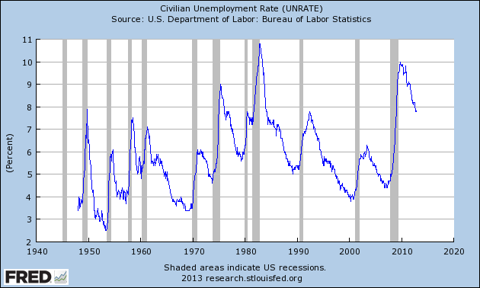
Coming to the first real indicator of the employment scenario, the number of people not in the labor force has increased by nearly 10 million to 88.8 million currently from 78.5 million at the beginning of 2008.
(click to enlarge)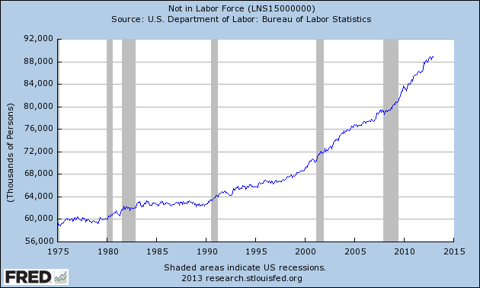
Therefore, over a period of four years, 10 million people have exited from the labor force, leading to a meaningful decline in the headline unemployment rate. I am not suggesting that this is the only factor leading to an improvement in the unemployment rate. All I am suggesting is that it has been one of the major contributing factors. Further, the factor is negative for the economy as an increasing number of people not in the labor force will put pressure on the employed due to an increased dependency ratio.
The point I am trying to make is reflected in the labor force participation rate, which has declined to 63.6% as of December 2012 from 66.2% at the beginning of 2008.
(click to enlarge)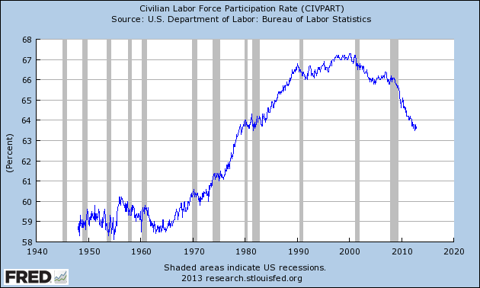
I must mention here that the labor force participation rate has been on a decline since the year 2000 and is reflective of the demographic problem faced by the United States and other advanced economies. In all probability, the labor force participation will continue to decline in the future leading to an increasing pressure on the working population and a lower per capita disposable income. The chart below, which gives the dependants as a percentage of working age, underscores my point on a continued decline in the labor force participation rate.
(click to enlarge)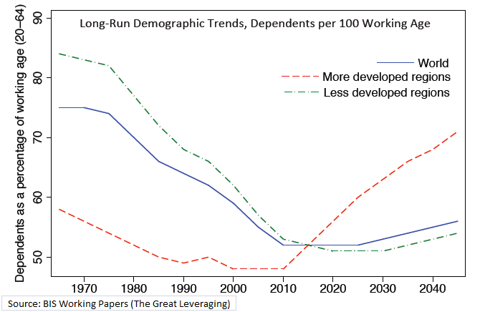
Another critical data one needs to look at is the kind of jobs created after the recession. The number of part-time employment (for economic reasons) in the United States was nearly 4.7 million at the beginning of 2008. Currently, the number of part-time employed has surged to 7.8 million.
(click to enlarge)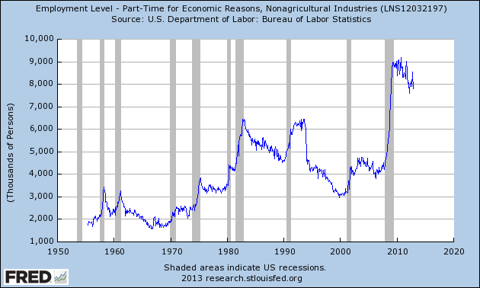
Therefore, nearly 3 million people have been employed part-time after the recession. Investors and readers might argue that employment is still being generated and income is flowing for 3 million people. I am primarily concerned because companies are skeptikal about the economic scenario and any visible decline in economic activity will lead to surging unemployment as part-time jobs are lost. Also, the income generated through part-time employment is relatively lower and does keep the consumer cautious. This is not good for a consumption-driven economy.
Finally, another factor that speaks volumes about the current economic and job scenario is the number of people receiving SNAP (Supplemental Nutrition Assistance Program) benefits. The number of SNAP participants has increased from 28.2 million in 2008 to 46.6 million in 2012. The increase (18.3 million) in participants for SNAP benefits is suggestive of the inherent weakness and increasing weakness in the economy.
(click to enlarge)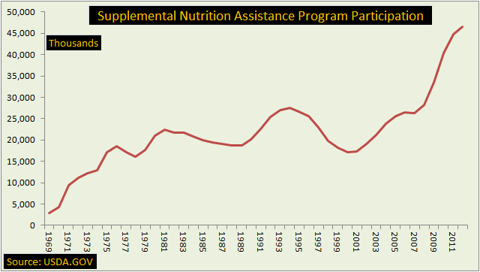
In conclusion, the expansionary monetary policies have done little for the real economy. The dynamic private sector has been the growth driver for the economy while the sluggish government sector threatens crowding out of the private sector. Policymakers need to introspect and think beyond zero-interest rates and easy money for banks and financial institutions. If current policies persist, real economic activity will remain sluggish for the long-term and real unemployment will remain poor.
From an investment perspective, investors need to have a balanced mix of defensive and aggressive stocks in their portfolio. If current monetary policies continue (very likely), asset markets might trend higher amidst weak economic activity. Also, markets currently look overbought and investors can expect some correction over the next few months. Any correction of 5-10% would be a good buying opportunity. I would consider the following investments for my portfolio:
SPDR S&P 500 ETF (SPY) - It has been proven that beating the index is not an easy task. Therefore, the strategy should be simple -- beat the index or invest in the index. From this perspective, SPY looks interesting. Also, with excess money flowing into risky asset classes, the S&P should trend higher over the next 3-5 years. The ETF provides investment results that, before expenses, generally correspond to the price and yield performance of the S&P 500 Index.
Seadrill Limited (SDRL) - I like Seadrill as it caters to the oil and gas sector, which I am bullish on for the long term. Also, the company offers a high dividend yield. SDRL provides offshore drilling services to the oil and gas industry worldwide, and is also an excellent long-term buy, in my opinion. The company has a diverse asset base of 24 drillships & semi-submersibles, 21 jack-up rigs and 21 tender rigs. Further, 18 newbuilds would serve as long-term revenue drivers once they come into operation in 2013 and 2014. SDRL currently has an order backlog of USD19.7 billion, which gives revenue visibility in the foreseeable future. Being the second largest ultra-deepwater player also serves as an advantage for SDRL in the long term. Investors can consider the gradual accumulation of this exceptionally high dividend yield (8.7%) stock.
SPDR Gold Shares ETF (GLD) - Investors can consider exposure to the hard asset for the long term. In the near term, some more correction in the precious metal is entirely likely. However, expansionary monetary policies and artificially low interest rates will trigger long-term upside in the precious metal. The GLD ETF seeks to replicate the performance, net of expenses, of the price of gold bullion.
Vanguard Consumer Staples ETF (VDC): Seeking a relatively defensive sector, I would consider exposure to VDC. The ETF seeks to track the performance of a benchmark index that measures the investment return of stocks in the consumer staples sector. The ETF has a low expense ratio of 0.19%. In terms of sub sector exposure within the consumer staples sector, the ETF has 19% exposure to the household segment, a 17.8% exposure to soft drinks segment, a 16.6% exposure to the packaged foods & meats segment, and a 16% exposure to the tobacco segment.
Vanguard Health Care ETF (VHT): The healthcare sector is also a relatively low beta sector and less prone to economic shocks. The VHT ETF seeks to track the performance of a benchmark index that measures the investment return of stocks in the healthcare sector. The ETF also has an expense ratio of 0.19%. In terms of sub sector exposure within the healthcare sector, the ETF has 45% exposure to the pharmaceuticals segment, a 16% exposure to the biotechnology segment, a 14.9% exposure to the healthcare equipment segment, and a 7.3% exposure to managed healthcare.
Johnson & Johnson (JNJ): This is a good investment option. I like this highly diversified healthcare company, with products as well as regional diversification. Further, the sector catered to by JNJ is not very prone to economic shocks. JNJ has been a good dividend payer in the past, with a dividend yield of 3.4%. In my opinion, the stock is excellent for the long-term portfolio as well. It also commands a higher rating than the U.S. sovereign rating.
Disclosure: I have no positions in any stocks mentioned, and no plans to initiate any positions within the next 72 hours. I wrote this article myself, and it expresses my own opinions. I am not receiving compensation for it (other than from Seeking Alpha). I have no business relationship with any company whose stock is mentioned in this article.
Source: http://seekingalpha.com/article/1117071-the-real-jobs-report?source=feed
hunger games box office xavier joan crawford joan crawford john goodman kendall marshall whitney houston news
No comments:
Post a Comment
Note: Only a member of this blog may post a comment.